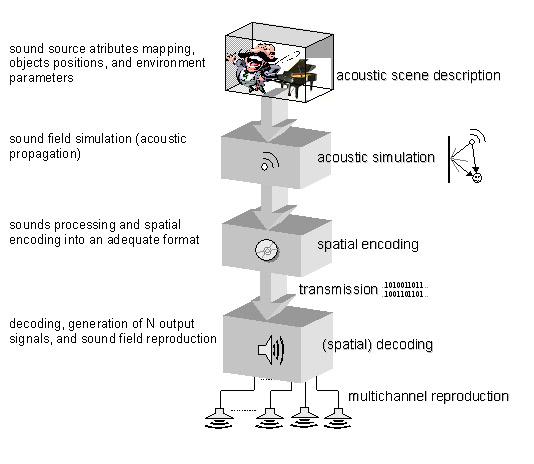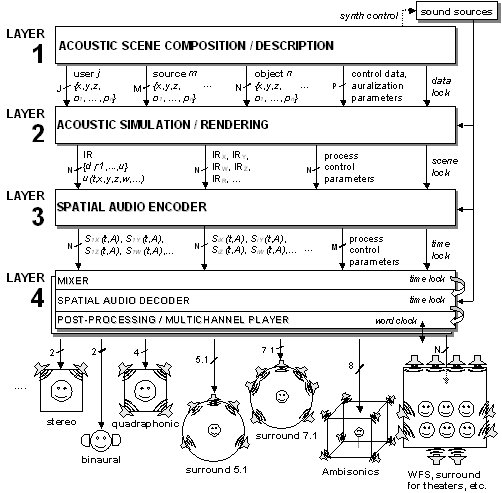The
Project AUDIENCE
The project AUDIENCE
was initiated in 2003
having as objective
the research of flexible
and scalable immersive
(surround) audio systems
for applications in
complete virtual reality,
that is, applications
where the sound and
the image are complementary
and acting jointly to
produce an experience
of immersion in the
virtual world.
For this, it was conceived
an architecture for
the audio chain involving
from the production,
the distribution, till
the final presentation
(reproduction), taking
care of the requirements
to generate the spatial
audio of a virtual scene.
Faria
(2005) proposed
a modular architecture
for auralization, oriented
to independent functional
layers. In this, there
are 4 main groups of
functions (processes)
to be executed in the
spatial audio production
and reproduction chain:
- the scene
production,
contemplating the
composition of the
auditory scene through
the description of
the environment, the
sound sources and
other objects with
their respective properties,
audiovisual positions
and parameters;
- the acoustic
scene simulation
(or rendering),
contemplating the
functions and techniques
responsible for calculating
the acoustic propagation
of the sounds in scene,
and getting an auditory
representation of
the sound at a certain
hearing position;
- the spatial
sound codification
of the scene, contemplating
the generation of
the transport media
that contains the
temporal and space
description of the
sounds in scene;
- the decoding
and reproduction
of the auditory scene
(multichannel reproduction),
responsible for the
spatial audio decoding
and for the generation
of the sounds that
feed each channel
(each loudspeaker)
used in the configuration
or reproduction setup
chosen by the user
(ex: stereo, quadriphonic,
biaural, ring with
8 loudspeakers, surround
5.1, etc.).

The main functions
chain for auralization
used in the AUDIENCE
system
Each functional group
is properly implemented
within one "functional
layer" in the AUDIENCE
system, as shown in
figure below:

AUDIENCE functional
layers architecture,
showing possible signals
between layers and audio
output modes
This approach presents
several advantages from
the point of view of
implementation, for
decoupling in a systematic
way the main processes
of the chain, allowing
that they are carried
through by independent
modules (in software
and/or the hardware).
A consequence of its
adoption is in the necessity
of specifying (or standardizing)
sets of (interface)
signals, parameters
and valid messages that
must pass from a layer
to another, so as to
make compatible the
output of one layer
with the input ports
of another.
Once a representative
set of signals to be
adopted is defined,
the solutions developers
will be able independently
to specialize or to
focus their efforts
in the development of
components for one functional
layer independently
from the others, stimulating
the diversification
of solutions for each
layer. The user or designer
of a final auralization
system will be able
then to adopt the desired
solutions in each layer,
selecting component
of different developers,
and extending the possibility
of synthesis of a component
system that combines
the techniques that
he/she selects to use.
Based in this architecture,
this project has as
main objective the development
of a modular and scalable
integrated software
and the hardware system
for production, distribution
and reproduction of
spatial/multichannel
audio. The deployment
of a family of software
distributions of auralization
machines is foreseen,
gradually incorporating
improvements in the
usability, integrability
and advanced functionalities.
Parallel, initiatives
for the conception of
new products with industrial
partnerships are in
progress.
|









